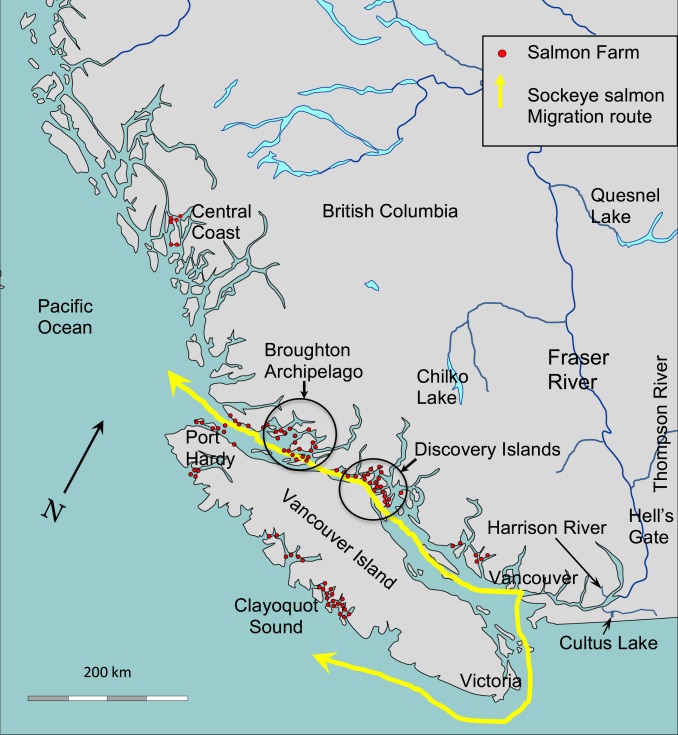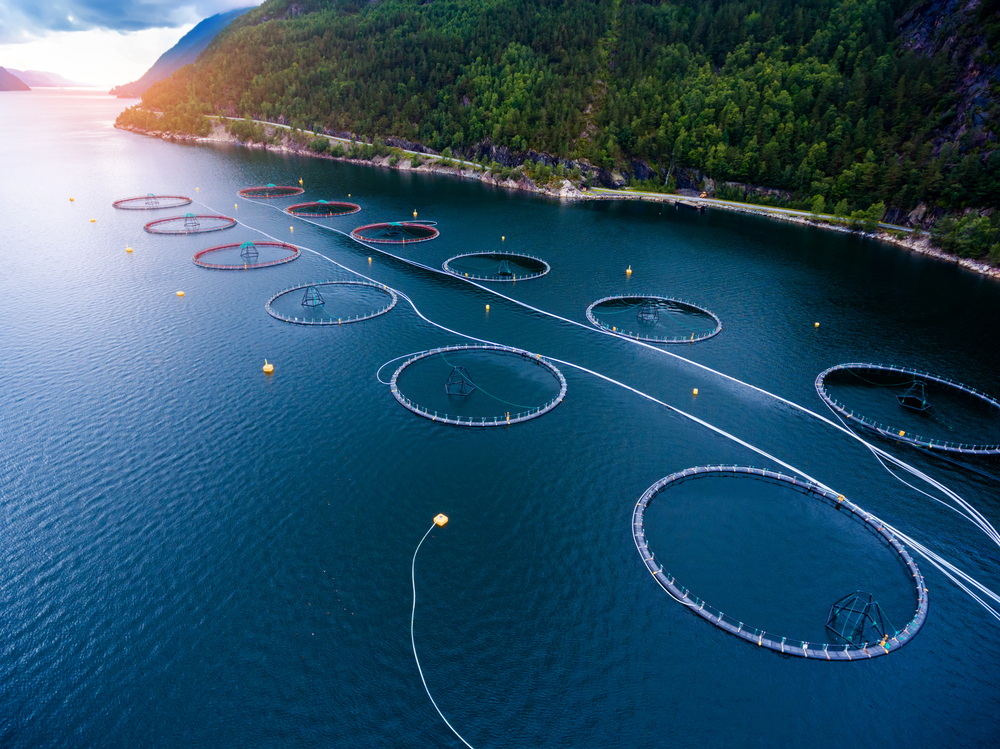New research by an international group of fishery scientists has detected a nasty heart disease, first identified in Norway, on a British Columbia fish farm in the Discovery Islands.
And the study revealed that dying fish with similar heart lesions had been retrieved from other farms in the same region between 2011 and 2013.
So what’s the big deal, you might ask? Doesn’t intensive factory farming, by definition, increase the risk for plagues of one kind or another among chickens, pigs and now Atlantic salmon?
Well, for starters, heart and skeletal muscle inflammation (HSMI) is already a big deal in Norway, where industry giant Marine Harvest ranked it as the number three killer of its farmed salmon in its 2015 annual report. The Norwegian Veterinary Institute even describes HSMI as “one of the most common infectious disease of farmed salmon in Norway.”
The disease confounds industry economics by reducing fish growth, increasing the amount of feed needed, and imposing financial losses on companies.
Second, the study not only confirmed the presence of HSMI in B.C. coastal waters — something industry and government have long denied — but showed a clear link between piscine reovirus (PRV) and the disease. “PRV was the only agent detected in heart tissue that was correlated with HSMI lesions in the heart,” the study found.
And that’s a problem because the PRV has been present in B.C.’s industrial fish farms and hatcheries for years. Industry has long maintained not only that HSMI is not present in B.C., but that piscine reovirus behaves differently here and has not been established as a cause of the disease.
But the paper reports there have been numerous cases of HSMI-like lesions in farmed fish since 2002, and most were likely HSMI.
The study also explained why the Department of Fisheries and Oceans (DFO), the industry regulator, probably failed to detect the disease: it didn’t sample enough fish or at the right time.
In addition, B.C. doesn’t use the international standard definition of HSMI for diagnosis, the study noted, instead using its own unique definition.
In 2013, provincial government fish pathologist Gary Marty stated in an affidavit used by Marine Harvest that “PRV is common in farmed Atlantic salmon and farmed Pacific salmon, but HSMI does not occur in B.C.”
But the study, which examined healthy, sick and dead fish from one farm over an 18-month period, confirmed that HSMI and PRV travel together even in B.C.
Marty said in an email to The Tyee that “this scientific paper is the first to diagnose HSMI in B.C. salmon” though not the first to diagnose heart disease in salmon in the province.
These findings are a big deal for two additional critical reasons.
The first concerns the little-studied risks of viruses to wild Pacific salmon whose populations have been plummeting for two decades while production from crowded fish farms has been increasing.
Unlike intensive factory farms on land, where contact between domestic and free ranging wild animals can sometimes be monitored and controlled, ocean-based feedlots provide ample opportunities for the spread of bacterial and viral infections.
In open pens, farmed Atlantic salmon can incubate and transmit a variety of infections to already diminishing stocks of wild fish.
But tracking the impact of these viral pathogens on wild fish is notoriously difficult because predators make quick work of sick or unhealthy fish in the wild, scientists note.
Norwegian researchers have confirmed that disease outbreaks on fish farms can impact wild fish, but they have been so busy studying viral plagues on fish farms that they know little about their impact on wild stock.
And in a 2016 presentation to a parliamentary committee, Kristi Miller, a respected DFO fish pathologist and one of the authors of the new study, noted that until recently, the DFO has shown little interest in researching impacts on wild fish while industry has often prevented access to farmed fish for disease studies.
“At present, the department relies heavily on information that the industry provides to determine, for example, what pathogens and diseases to focus risk assessments on,” she told the committee. “There are not, to date, any provisions to enable scientists to conduct risk assessments to sample fish on farms unless the industry agrees to provide them.”
The new study, part of the Strategic Salmon Health Initiative, represents the first time Canadian scientists have had access to farmed fish from one industrial facility over a continuous period of time.
The second big deal concerns federal fishery law.
Given the importance of wild salmon to the province’s ecology and the disease risks posed by industrial farms in the ocean, First Nations, commercial fishermen, the tourist industry and thousands of B.C. residents expect that federal regulations should guarantee that fish farming has minimal impacts on declining wild stocks and that scientific monitoring be transparent, objective and independent of industry influence.

But the federal government’s response has been anything but diligent.
Under Canadian law, it is illegal to transfer diseased or infected fish from holding pens or hatcheries into ocean waters in Canada — yet that’s now a daily reality in B.C.’s farmed fish industry.
In 2015 a federal judge ruled that DFO couldn’t download its responsibilities for fish health to the industry, letting corporations decide when and how to transfer diseased fish.
In addition, the judge said the government must respect the precautionary principle and test all farmed fish prior to being transferred to ocean pens for the PRV virus.
Marine Harvest and the federal government appealed — the government later dropped its effort — and the practice continues.
About 80 per cent of farmed fish test positive for PRV, and that inconvenient reality is now the subject of another lawsuit launched last year by biologist and wild salmon advocate Alexandra Morton against the minister of the Department of Fisheries and Oceans.
Given the clarity of the law and the 2015 ruling, Morton wants the DFO to test farmed smolts for PRV before they are introduced to the ocean.
Despite the 2015 federal court ruling, the DFO has refused to do so.
Japanese-owned Cermaq has disclosed that one of its farms in the Discovery Islands has HSMI, and Marine Harvest confirms that fish in many of its hatcheries have PRV.
In documents filed in federal courts, both companies have argued that any requirement to test for fish infected with PRV would severely curtail their operations.
Cermaq argued in a notice of motion filed in federal court this year that requiring the industry to test for PRV would have dramatic effects. “This would effectively be preventing Cermaq from transferring fish between its marine farms because all populations of fish, after having been transferred to the marine environment, have a significant proportion of fish which test positive for PRV within two to six months of being transferred to the marine environment,” the company said.
Morton says the new study’s implications are formidable. Canada may have to change its fishery laws or outlaw a virus-spreading industry near wild salmon migration routes, she said.
Or it may have to admit to the public that it is permitting Norwegian and Japanese corporations to introduce viral diseases near major migration routes, she added.
So just what is HSMI and where does it come from?
HSMI’s infectious story begins in Norway, once home to the world’s most productive wild Atlantic salmon rivers.
But in the 1970s the Nordic nation pioneered the technology for farming masses of Atlantic salmon in open net cages.
At first the technology worked economic wonders. Over four decades the industry steadily increased production from 500 tonnes to 743,000 tonnes by 2008, as it expanded into fjords up and down Norway’s coast.
In the 1980s and 1990s the Norwegians aggressively exported the novel industry to coastal waters in Scotland, Ireland, B.C. and Chile. Few regulations or safeguards were in place.
But as volume of farmed fish expanded, thanks to larger and deeper ocean cages, so did the biological impacts of overcrowding in Norway’s coastal waters. Problems also arose in Chile, Scotland and B.C.
As salmon farms invaded waters formerly occupied by their wild cousins, the “systems” invited bacterial and viral disease outbreaks and attracted massive sea lice infestations, while escaped fish introduced bred with wild salmon.
Researchers noted that as the biomass of farmed fish grew in the ocean, Norway’s native fishery declined precipitously from an annual catch of 1,500 tonnes in the 1970s to less than 800 tonnes in the mid-2000s.
Viruses likely played a significant role in this quiet environmental disaster and many targeted the hearts of fish.
Like humans packed into cities, farmed Atlantic salmon typically suffer from a variety heart ailments including arteriosclerosis.
In crowded pens the fish have less oxygen to breathe and exercise less, while consuming the equivalent of a constant fast food diet.
Farmed Atlantic salmon seem particularly vulnerable to viral diseases that target the heart, including heart rupture or cardiomyopathy syndrome, pancreas disease and heart and skeletal muscle inflammation, or HSMI.
HSMI emerged as a new infectious menace in 1999 on just one fish farm located on the west coast of Norway.
The disease inflamed the heart, accumulated fluid in the abdomen, yellowed the liver and swelled the spleen. Fish afflicted by HSMI looked anemic and swam poorly. They often bunched up along the edges of open net cages. HSMI changed the condition of hearts in 100 per cent of the fish, and often killed as many as 20 per cent.
Nor did the disease stay in one place. Within a decade HSMI was responsible for more than 150 outbreaks each year on farms up and down the Norwegian coast. HSMI appeared in Scottish fish farms in 2004 and caused scores of outbreaks in the Shetlands over the next decade.
By 2008 HSMI had become such a commercial burden for the industry that the Norwegian Food Safety Authority declared it a notifiable disease.
And by 2010 researchers had identified piscine reovirus as a “plausible” viral cause for HSMI.
Researchers pointedly noted that reoviruses also affected poultry factory farms, where industry also confined animals in high-density conditions.
At the same time scientists also warned that “it is urgent that measures be taken to control PRV not only because it threatens domestic salmon production but also due to the potential for transmission to wild salmon populations.”
That same year research funded by the Research Council of Norway concluded that the fish farming industry had been allowed to expand at the expense of traditional fisheries and biodiversity.
PRV has now been documented in a number of wild and farmed fish species in Canada, Chile, Norway and Scotland — or almost everywhere the industry has set up shop.
By 2012 Norway’s Scientific Advisory Committee for Atlantic Salmon Management belatedly raised concerns about how infectious diseases in farmed Atlantic salmon might affect the survival and sustainability of wild stocks, while admitting little was known about disease exchanges between masses of industrial fish and their wild cousins.
By 2015 Scottish researchers referred to PRV as “an underestimated pathogen.”
Scottish experts also suspect other diseases might result from PRV infection, including erythrocytic inclusion body syndrome, which can cause mass die-offs in farmed coho and Chinook salmon.
Although there have been reports of HSMI-like disease in British Columbia since 2002, industry and government persistently denied its presence until the new study was published last month.
Provincial fish pathologist Marty is still not convinced that PRV causes HSMI. He told The Tyee that he does “not support the hypothesis that PRV is the cause of any disease in B.C. salmon.”
However most Norwegian researchers and even that nation’s annual fish health reports regard PRV as the probable cause of HSMI.
One 2014 report typically described PRV as “causative agent of HSMI.”
“Since PRV infections are widespread in farmed salmon, may readily be transmitted, and is detectable in less than 10 per cent of the wild salmon examined, it is considered likely that PRV is transmitted from farmed to wild salmon. HSMI occurrence in wild salmon and other wild fish are unknown.”
It is also noteworthy that Norwegian researchers now believe “that the main reservoir of PRV is in farmed salmon in the marine environment.”
Yet many technical questions remain unanswered about the virus’s precise role in causing disease. For example, both healthy and sick fish can carry high loads of the virus.
But the new study offers an explanation for what is a common trait of many viral infections.
Researchers found, for example, that the virus first moves into red blood cells in healthy fish but only attacks the heart when fish are exposed to environmental stress such as another viral disease, algal blooms or sea lice.
The next big question is “What is the risk of this disease in Pacific salmon, and/or the risk of transmission of this virus between wild salmon and farmed salmon?” asked the study. Nobody has those answers yet.
But HSMI’s impact on factory fish farming has been no mystery to the industry.
In a bluntly worded 2013 financial risk statement, Marine Harvest, the leading producer of farmed fish in B.C., acknowledged that its “operations are subject to several biological risks which could have a negative impact on future profitability and cash flows.”
The company singled out HSMI as just one of those risks, noting that disease had become widespread on its farms in Norway and Scotland.
Moreover the disease disrupted the effectiveness of the technology for raising large concentrations of fish in a small area and cost millions to manage.
“As HSMI often occurs or intensifies following grading, movement and other management events which may stress the fish, the disease leads to challenges in relation to sea lice treatments and other events necessitating the fish to be moved,” said Marine Harvest.
And now HSMI is here in British Columbia and the virus mostly likely associated with the disease is the subject of major lawsuit against the federal government.
More big deals are assured. ![]()
Read more: Environment

















Tyee Commenting Guidelines
Comments that violate guidelines risk being deleted, and violations may result in a temporary or permanent user ban. Maintain the spirit of good conversation to stay in the discussion.
*Please note The Tyee is not a forum for spreading misinformation about COVID-19, denying its existence or minimizing its risk to public health.
Do:
Do not: